This article originally appeared in CarLustBlog.com on November 7, 2012. Aside from some editing, revitalized hyperlinks and a couple of additional pics, it’s all the same.
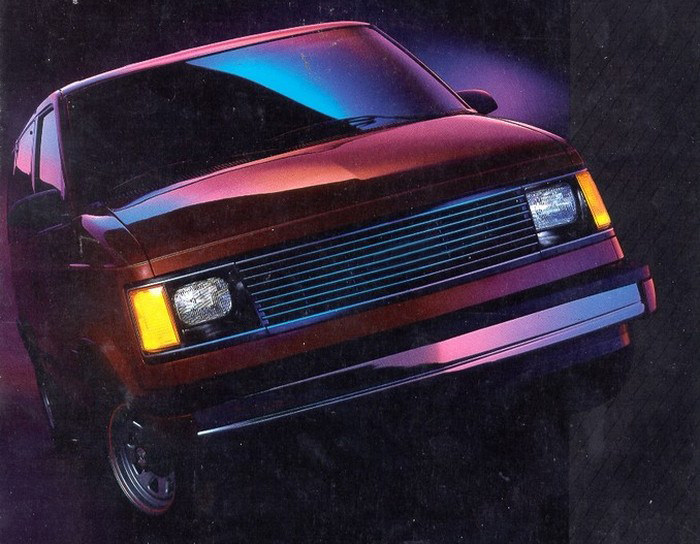 There used to be an article comparing the Safari and the Astro with their cousins, the “Dustbuster” minivans. Judging by the results and by the comments, the Astro/Safari won, though it must be said that the “Dustbusters” gave them a ride for their money. In said article, written by a close friend of this blog, we find this rather summarizing piece of information:
There used to be an article comparing the Safari and the Astro with their cousins, the “Dustbuster” minivans. Judging by the results and by the comments, the Astro/Safari won, though it must be said that the “Dustbusters” gave them a ride for their money. In said article, written by a close friend of this blog, we find this rather summarizing piece of information:
“The Astro and its Safari twin debuted in 1985 and represented GM’s first response to the revolutionary and amazingly successful Chrysler minivans. The Astro was an odd fit in the segment–perhaps unsurprisingly, considering it was a 1980s GM product, the Astro represented an attempt to compete with the ground-breaking Chrysler minivans without really capturing what made them so special.
The defining characteristic of the Chrysler minivans was their remarkably efficient packaging. The combination of a compact four-cylinder engine, front-wheel drive, and a modified small-car unibody chassis meant that the minivans had a low, flat floor and plenty of space despite their trim, Plymouth Reliant-sized footprint. The result was a vehicle that was as easy to drive and park as a compact car but that could also swallow a large family and their gear–revolutionary in a world dominated by large, low station wagons and hulking, full-size, truck-based vans.
The Astro, on the other hand, was a minivan in the sense that it was smaller than a full-size van, but that’s all it really was. Like the full-size vans, the Astro had a rear-wheel-drive powertrain, a large pushrod V engine (a V-6 in the Astro’s case), and truck-like body-on-frame construction. It was bulkier and heavier than the Chryslers, the passenger compartment was less spacious and efficient, and the driving experience was far more truck-ish. If the Chryslers were revolutionary; the Astro was decidedly evolutionary.
All of this set up a choice for the public between two fundamentally different types of minivans, and over the last 25 years the market has definitively chosen the Chrysler model of front-wheel-drive, car-like minivans. You would think this would have made the Astro an embarrassing failure, and really the story almost writes itself–GM tried to jump into a wildly popular new segment with a half-hearted effort, missed the market, and suffered a colossal sales failure. Interestingly, though, that didn’t happen with the Astro. Despite its competitive disadvantages, the Astro successfully carved out its own niche and sold well enough to warrant a 20-year production run with only minor changes. It even outlasted and outsold the broadly similar Ford Aerostar.
Ultimately, the Astro established itself as a successful and enduring design precisely because it was different from the established minivan paradigm. The Astro wasn’t as pleasant or car-like as the Chrysler minivans, but it was sturdier and stronger. Its primitive but powerful V-6, body-on-frame chassis, and optional AWD meant that the Astro could tow more, carry more, and could go more places than its competitors. As a smaller, trimmer, more efficient version of the traditional full-size vans, the Astro was also a legitimate competitor in the commercial and fleet market in a way that other minivans never truly were. Apparently there was a niche between minivans and maxivans, and the Astro filled that niche nicely.”
— Chris Hafner, CarLustBlog.com

I have to admit that adding more to the above is going to be difficult, but I’ll start by saying this: Though it’s true that they are truck-like in nature, M-bodies were NOT body-on-frame, but of unitary construction with separate front subframe (think Chevrolet Nova and F-bodies).
20 years is quite a life-span to cover when talking about car models. As time passed, it got tweaked here and there; new technology, like ABS, was added, but nothing out of the ordinary. Notable mentions include the introduction of the popular extended body-option (with the same wheelbase, so I won’t be calling these puppies long-wheelbase, as it’s sort of a misnomer), “Dutch doors” 3-door system, the Iron Duke/Tech4 I-4 was dropped; AWD availability (a first for minivans) and new dashboard, the appearance of the 3 slots under the grille for 1990, the disappearance of manual transmission models, the redesign for ‘95 solely on the extended body (as in no more shorter versions), an interior redesign for ’96, 6-lug pattern conversion and suspension upgrades for ’03, and… that’s about it. If you wanna know about its hydroboost system, from which vehicles’ parts bin did some of the suspension parts came from, or the implementation of Scotchgard to the seats, go to Wikipedia, of all places.
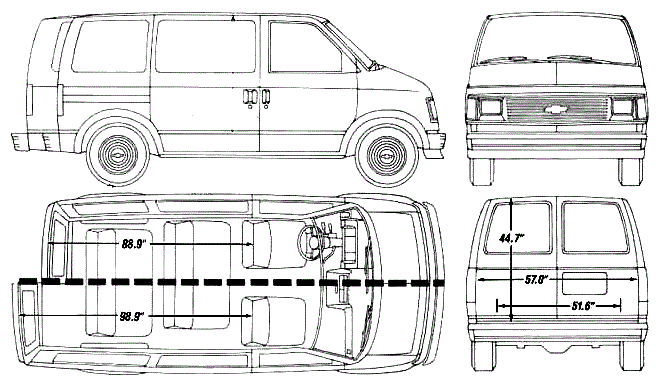
As mentioned, they’re GM’s contender to the revolutionary Chrysler minivans, but with a charm all their own. GM made a point that the M-bodies are not small, nor car-based, attributes that Chrysler even sneered at in one of their ads (which I tried but couldn’t find a bigger pic for this post), but whose purpose in life are broader than a Plymouth Voyager’s.
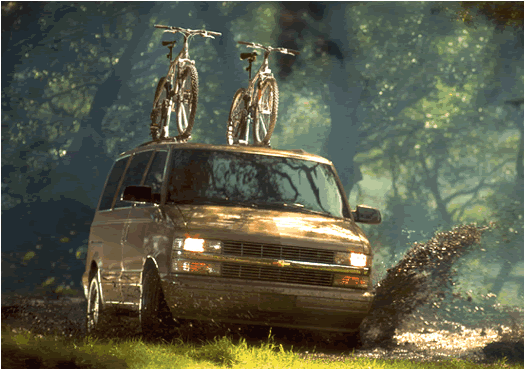
An M-body can not only haul 7-8 (depending on seat configuration), it can also pull trailers and haul equipment around. Chevrolet drove the point home of the Astro’s utilitarian nature when the company sponsored Hometime, a DIY home improvement TV/VHS program. I have to admit that the Chevy-sponsorship is one of the reasons why I bought one of their VHS.
As much as people love these two, short-comings and all, there’s something that the Astro/Safari twins, particularly the post-1995 model years, will have to live with: their Insurance Institute for Highway Safety 1996 frontal offset crash test. Look at the video. It’s not pretty.

This is by no means the un-safest vehicle of the ‘90s (there were many other candidates). The M-body failed on that test (one-star rating), but did well, and got better, on National Highway Traffic Safety Administration tests (three-star to five-star, depending on test). Still, the damage was done. The Astro/Safari twins were pulled out of market… 9 years later. Lol.

Look at the above specimen. Now back to me. Now back to the specimen. Now back to me. With a little imagination, this could be a blank canvas to express the individual that you are, whether for personal or commercial use. Taxis, customs, rolling canvases, 4x4s, lowriders, hot-rods, etc., are some of the venues these two have been used for in the rich automotive landscape.
It goes without saying that these vans were primo candidates for conversions. These covered more than just recreational vehicles. You can find these third-party conversions from many companies whose products ranged from mild to wild. Some even went full-on RV-style called campervans. Needless to say these babies have a following. While many wheel designs look great on the M-bodies, for some reason many owners around these parts opted for the 3rd-gen Camaro Z28 or IROC-Z-style wheels (extra brownie points if they’re actual IROC-Z wheels, any of the designs) for their conversion vans (and, yes, standard versions too).

A college professor of mine was considering buying one of those conversion vans, used, until a good look revealed a bug infestation. So aside from the mechanical, inspect the interior with a fine-tooth comb to avoid an experience that rivals staying on a cheap motel room.
Anybody that has been around M-bodies long enough might have heard this interesting piece of information: Chevrolet Astros and GMC Safaris have a cult-following… in Japan. As weird as it sounds, it’s true (they have a pretty big van scene involving many makes, foreign and domestic, but let’s stick with these for now). There’s an aftermarket for them, so it’s not only the US that get to have fun with these body styles. Here are the crème de la crème:

I had a notion of this from one of the most unlikely sources: anime. While I was a burgeoning anime enthusiast in 2000, I was watching one of my first shows of the genre that I actually saw contemporary life in Japan at the time (to an extent, the show was about digital monsters).
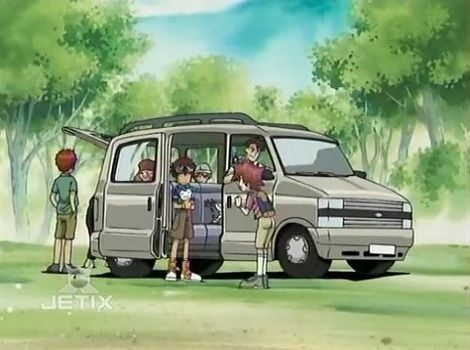
One of the scenes that I more fondly remember was during one of the climactic battles in which monsters was destroying the city block (Destruction? By monsters? In Japan? Nah!), and out of nowhere comes this familiar-looking box on wheels driving dangerously close to the action, driven by one of the main characters’ father (admittedly, the scene was so much cooler back in the eyes of the me of 2000)!! Sure, a blast wave caused the van to lose control and end up on its roof, but still..! All I know is that I liked its boxy shape. Yet, the level of detail in that show is one of its highlights for sure! Unless you’re a child of the 90s, I don’t recommend watching the show.
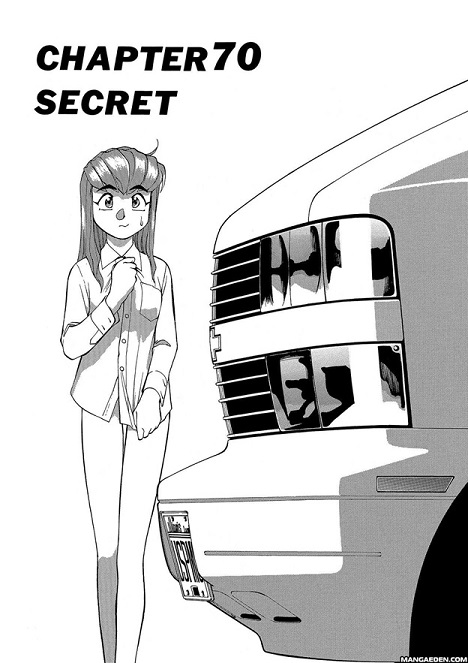
By the way, this isn’t the only anime that hosts the M-body. They have a nice repertoire in film and TV. Even graphic novels!
Speaking of foreign-market M-bodies, check out the rear Euro-treatment on this ’95 model:
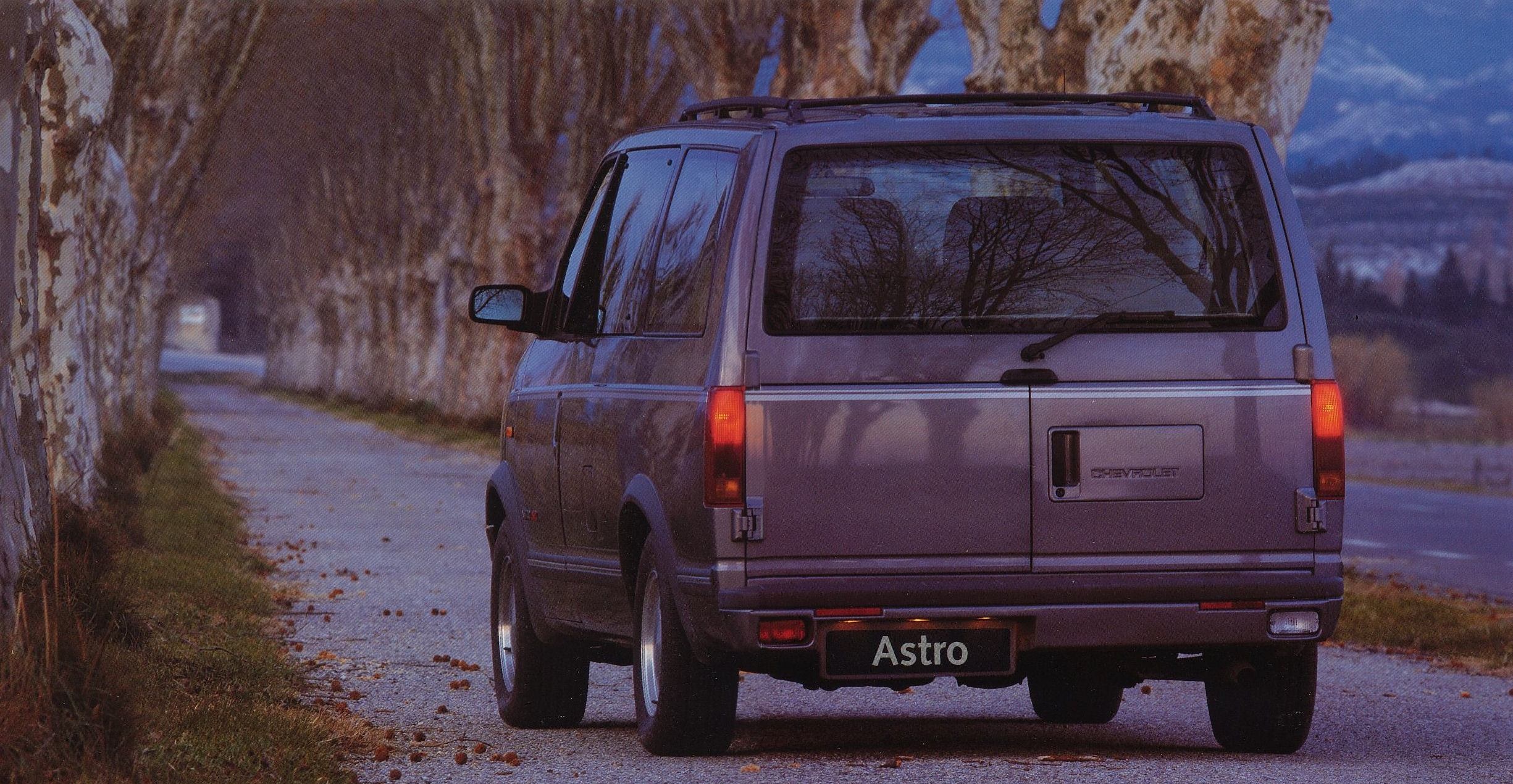
Cool, huh? It came from a German brochure. I cannot confirm whether or not German (or any other EDM) models actually had this tail-end treatment and isn’t brochure only, as pics of those foreign market M-bodies are very few and not from the rear. But I couldn’t pass up this opportunity to share this interesting international spin on a North American vehicle.
While my family never owned one, I knew people close to me who did.
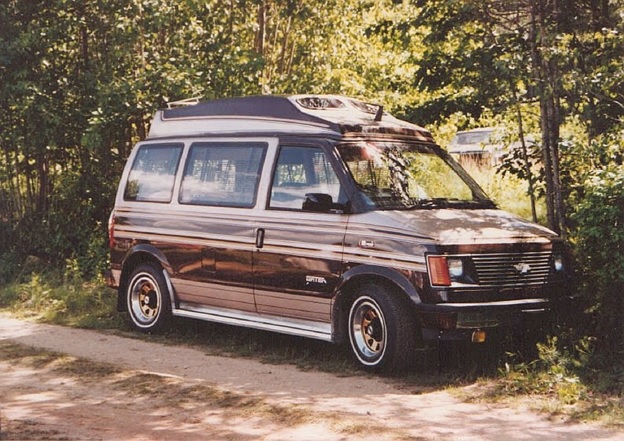
I recall a family at church who had (and as far as I know still have) one, an early Astro conversion van, very similar to the one in the pic above, colors and all, but the graphic pattern was different. It was fully loaded. It had TV, an RV-style ladder, that sweet boomerang TV antenna (that as a kid I thought one could watch all the channels on regular TV) and VHS!! Foam-at-the-mouth stuff for a child of the 1990’s.
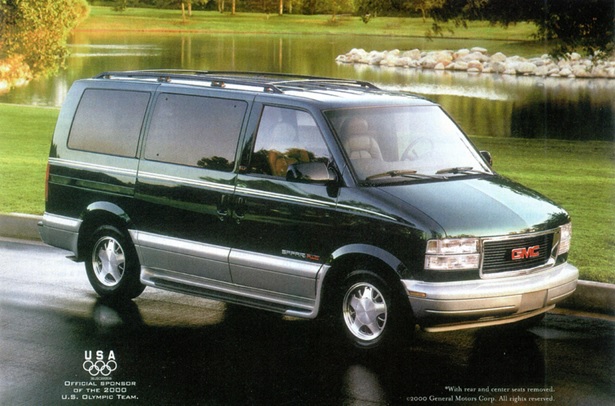
Another church family also had a second-gen M-body, a GMC Safari, which I went with them in it to one of the biggest antique car shows on the island. But there was something wrong with the paint, it was eaten away! It had more surface rust and exposed metal than paint. And it wasn’t the only Safari (and Astro) that I’ve seen that suffered from this. What’s up with that? Seriously, I couldn’t find any info on that. It looked like the one above, with the lower portion and wheel accents painted gold and, of course, the body was missing a lot of what I believe is called “Dark Forest Green Metallic” paint. I would comment on the interior, but it was a mess. It was their do-it-all vehicle after all.
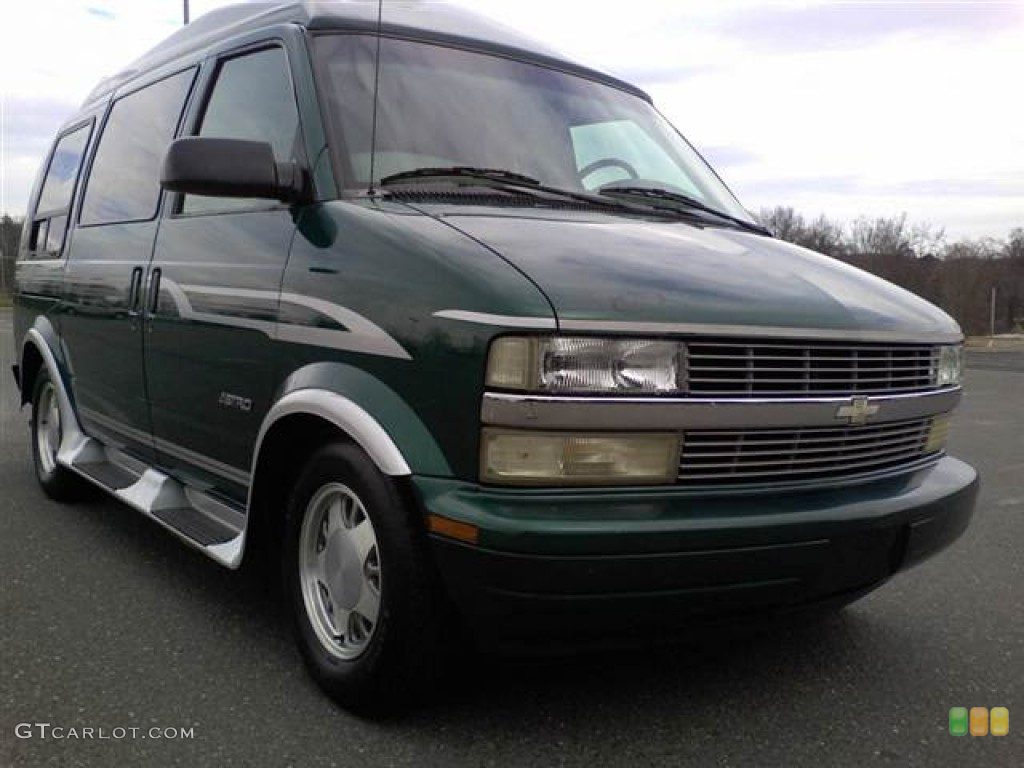
My uncle (yes, ZZW30 MR2 uncle) also had an Astro conversion van, called a Mark III, for a while, but a 2000-ish model year, for his wife to use to replace her high-mileage first-gen Ford Expedition. It even appeared in the news on a bit about Christmas tree sales when it was pulling away from the lot! After my cousin hit a metal-bar fence with it (real smooth, cuz), the green/gold accents Mark III got fixed (and the fence) and sold for another Expedition, a second-gen. Uncle likes Expeditions.

The most time spent with an M-body came with the surprising purchase from my aunt (MR2 uncle’s older sister), a well-optioned, champagne-like or sand-esque-colored 2002 Chevrolet Astro, eerily similar to the pic below, running boards an all, minus window visors. It was quite a leap in size when compared to her trusty but aging Jeep Cherokee. Like all their cars, her husband took real good care of it and detailed it, adding tape stripes and reflectors. Minus the reflectors, it looked sharp. Despite the fact that there were a number of times the A/C had to be fixed, the e-brake cable and alternator needed to be replaced, the neutral switch acting up, which got bypassed and still continued to act up; she liked that beast. She sold it to a dealer this year, who quickly found a buyer for it, and got a new-ish 2011 Toyota Sienna LE that took more space lengthwise and made the Astro look like an easier van to park!
I was already of driving age by this time. My impressions on how the thing handled aren’t that accurate because the few times I drove my aunt’s Astro, it wasn’t exactly in its best shape. The first time I drove it, the brakes were hyper-sensitive, so a small tap stopped the box violently. I was very disappointed of the thing. The time I drove it back home after getting that neutral switch bypass thing done (something of a weak point I’m told), I was more focused on trying to see through the extremely dirty windshield and avoiding any surprises the road might throw at me as people were getting ready for the weekend (it was a Friday). It was an interesting sensation driving a vehicle whose wheels were fairly tucked into the cab and with such a short snout, making parking a different experience to what I’m used to. As a middle-row passenger, it seems that it was missing a plug in the undercarriage or something, because since it was raining, water came in and on me when the box passed over a puddle at speed!
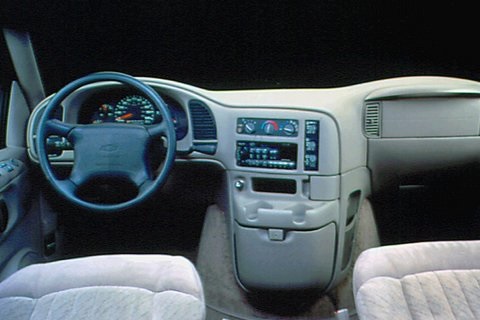
It was the first GM vehicle of that era that I’ve driven that dated back to the mid-90s. The switchgear looked toy-like, but felt durable. The passenger grab-bar looked up for the job, but it broke and was glued back. Those wheel-wells tucked into the cab, my left foot rested on the wheel well intrusion when I drove, and felt awkward. Heck, it felt cramped! For a vehicle that was designed for North Americans, I was disappointed to find that the seat didn’t go that far back. The sliding door (with an interesting door-handle) was heavy compared to a 3rd-gen Dodge Caravan, and I never got used to the “Dutch doors,” whose electric lock on the liftgate needed attending to. Speaking of doors, my aunt’s husband did quip about how the front doors could have used a couple more degrees when opening to ease entry.
But my relationship with the M-bodies stem from way back, when I was 3½ years old. On one of the first trips to Disneyworld, my uncle (MR2 uncle’s older brother) rented a Chevrolet Astro (all these years I thought it was a GMC Safari. Oh, well. Further inspection will reveal it was the extended body with “Dutch doors” and ABS). It’d be safe to say it was probably the first M-body I’ve ever seen!
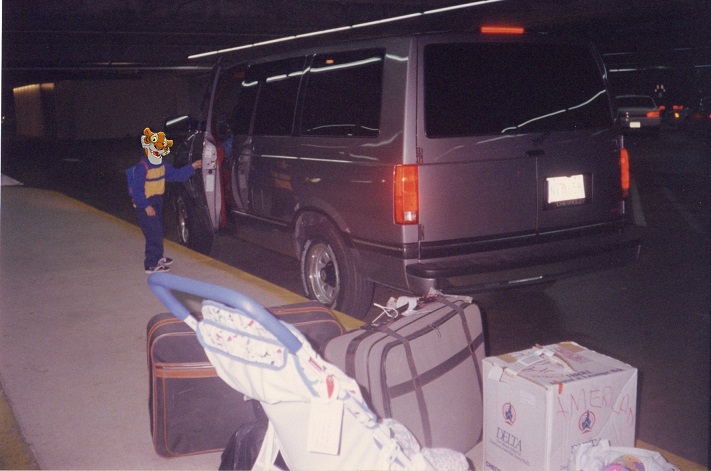
There it was, gun-smoke gray and shiny, pulling onto the sidewalk before heading out into the night. It was new, as its red interior had that new-car smell, so I believe it was a ’93 model-year. But being that smell is the strongest sense tied to memory, every time I smell that new-car smell I briefly get sent back to that happy time… The Astro was our trusty steed throughout that magical, unforgettable time. You could also say that I was taught about rentals thanks to this box.
I still like the Astro/Safaris. I gotta admit that after doing research for this post, I wouldn’t mind a Safari GT (here’s its Astro twin, the RS) with enough windows for everyone to see, but not so much that I need to double up on my Windex budget. It just looks different. It would be cool if it was a 5-speed manual model, but I gotta get in one and see how comfortable it’ll be in that seating position while rowing gears. But this isn’t my first time that I’d dream of owning a Safari.
Back in the early-mid ‘00s, when the whole “urban lifestyle/Baller” scene was in full swing, I lusted after the Jada Toys model. But I knew how I wanted my GMC Safari. Using a panel van as a starting point (read: no “Dutch doors” and windows), my Safari was heavily inspired by a vintage van in yet another childhood cartoon. It was gonna be retro, with a yellow graphics to complement the purple paint. Having very recently learned that cargo vans had their own headlight buckets, regardless of year (so did basic-trim passenger models, but up until 1997 from what I’ve observed), those would’ve given way to the passenger van units. Inside, there was going to be wall-to-wall shag carpeting, a full-blown stereo and a waterbed. And it was going to be slammed with huge 5-spoke rims (What? It was the ‘00s). If I was gonna have at it today, I’d add murals, portholes, perhaps a roof scoop, extra lights, and deep chin spoiler and a wing in the back, inspired by B.A. Baracus’ A-Team GMC van. Or go all Japanese-inspired. What can I say? I got a bit of a vanner in me.

Time has passed since the night I drew my then-ideal Safari while listening to Christian music. Honestly, I’m not sure if I’ll ever own a Safari, or any van for that matter, but you know what, I’d be OK if these remain a part of my childhood. Like a huge box that one used to play pretend in.
If I do get one of these, it won’t take a stretch of the imagination to send me back to all of those good times that I recall.
Especially if I succeed in getting that new car smell right.
–Tigerstrypes
The following are the 1985 Chevy Astro commercials. Vintage CGI at its finest:
I must say that those that made these commercial really went all out, as the CGI for the Astro is -as far as I can tell given the quality (a shame)- one of the best that I’ve seen. The second one evokes scenes from that highly-influential CGI animation film series, The Mind’s Eye. But it’s that jingle that really sticks to ya!
♪Chevy, Chevy, Astro, Astro…♪
References:
Photoshop’d (by me and friends) M-body’s original pic: http://images.hemmings.com/wp-content/uploads//2010/12/1985ChevroletAstro_700.jpg
Early 2-tone, clear glass GMC Safari with hubcaps pic link: http://images.hemmings.com/wp-content/uploads//2012/02/1987-GMC-Safari-Van.jpg
Chevy Astro measurements pic link (converted to jpg by moi) originally from here: http://i105.photobucket.com/albums/m240/chevy57bert/astro%20spec/chevrolet-astro-1990.gif
Chevy Astro frolicking in the mud original pic: http://www.minivansearch.com/photos/chevy_astro7.gif
Astro crash test pics: http://i.ytimg.com/vi/8kuSghb7P7U/0.jpg
White canvas, err, GMC Safari cargo van pic link: http://imageonthefly.autodatadirect.com/images/?IMG=U5GTGEF2.JPG&WIDTH=400&AUTOTRIM=2
Chevrolet Astro conversion van ad is from that good Curbside Classic post:
WALD body-kit-equipped Astros pic links:
Anime Astro hero van is from here:
http://www.imcdb.org/vehicle_412189-Chevrolet-Astro-1998.html
Gunsmith Cats chapter opening pic: www.mangaeden.com
Cropped (by me) German-spec 1995 Chevy Astro brochure pic: http://storm.oldcarmanualproject.com/chevrolet/Chevrolet%20Astro%201995%200607.jpg
Gold/brown/black Chevrolet Astro conversion van pic link: https://itrolls.files.wordpress.com/2017/01/7f11f-vanscan.jpg
Edited (because similar pics sucked) 2000 GMC Safari pic originally from here: http://www.flickr.com/photos/ifhp97/6233548274/
Green Chevy Astro Mark III conversion van pic link: http://images.gtcarlot.com/pictures/59732546.jpg
Champagne-like/sand-esque-colored 2002 Chevy Astro pic link: http://trialx.com/curetalk/wp-content/blogs.dir/7/files/2011/06/cars/2002_Chevrolet_Astro_Cargo-3.jpg
Second-gen later dash: www.howstuffworks.com
The GMC Safari drawing pic and the Chevy Astro vacation pic are mine.



Pingback: The Cars of Top Gear USA | It Rolls.
Pingback: “Bosozoku”/Zokusha car style, a guide: | It Rolls.
Pingback: The Mystery Machine | It Rolls.